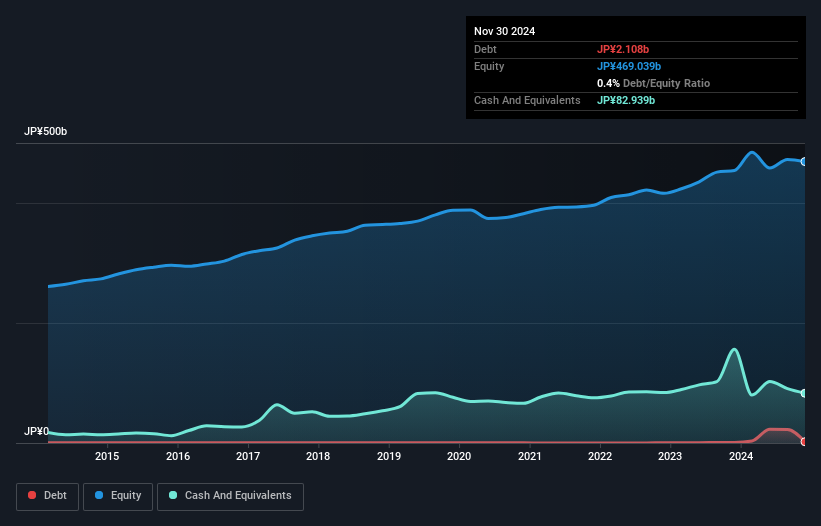Howard Marks put it nicely when he said that, rather than worrying about share price volatility, 'The possibility of permanent loss is the risk I worry about... and every practical investor I know worries about.' When we think about how risky a company is, we always like to look at its use of debt, since debt overload can lead to ruin. We note that Toho Co., Ltd. (TSE:9602) does have debt on its balance sheet. But is this debt a concern to shareholders?
What Risk Does Debt Bring?
Debt assists a business until the business has trouble paying it off, either with new capital or with free cash flow. Part and parcel of capitalism is the process of 'creative destruction' where failed businesses are mercilessly liquidated by their bankers. While that is not too common, we often do see indebted companies permanently diluting shareholders because lenders force them to raise capital at a distressed price. By replacing dilution, though, debt can be an extremely good tool for businesses that need capital to invest in growth at high rates of return. When we examine debt levels, we first consider both cash and debt levels, together.
See our latest analysis for Toho
What Is Toho's Net Debt?
You can click the graphic below for the historical numbers, but it shows that as of November 2024 Toho had JP¥2.11b of debt, an increase on JP¥924.0m, over one year. But on the other hand it also has JP¥82.9b in cash, leading to a JP¥80.8b net cash position.

How Healthy Is Toho's Balance Sheet?
According to the last reported balance sheet, Toho had liabilities of JP¥66.4b due within 12 months, and liabilities of JP¥59.1b due beyond 12 months. On the other hand, it had cash of JP¥82.9b and JP¥48.6b worth of receivables due within a year. So it actually has JP¥5.99b more liquid assets than total liabilities.
Having regard to Toho's size, it seems that its liquid assets are well balanced with its total liabilities. So while it's hard to imagine that the JP¥1.22t company is struggling for cash, we still think it's worth monitoring its balance sheet. Succinctly put, Toho boasts net cash, so it's fair to say it does not have a heavy debt load!
In addition to that, we're happy to report that Toho has boosted its EBIT by 39%, thus reducing the spectre of future debt repayments. When analysing debt levels, the balance sheet is the obvious place to start. But ultimately the future profitability of the business will decide if Toho can strengthen its balance sheet over time. So if you're focused on the future you can check out this free report showing analyst profit forecasts.
Finally, while the tax-man may adore accounting profits, lenders only accept cold hard cash. While Toho has net cash on its balance sheet, it's still worth taking a look at its ability to convert earnings before interest and tax (EBIT) to free cash flow, to help us understand how quickly it is building (or eroding) that cash balance. In the last three years, Toho's free cash flow amounted to 45% of its EBIT, less than we'd expect. That's not great, when it comes to paying down debt.
Summing Up
While we empathize with investors who find debt concerning, you should keep in mind that Toho has net cash of JP¥80.8b, as well as more liquid assets than liabilities. And it impressed us with its EBIT growth of 39% over the last year. So we don't think Toho's use of debt is risky. Over time, share prices tend to follow earnings per share, so if you're interested in Toho, you may well want to click here to check an interactive graph of its earnings per share history.
Of course, if you're the type of investor who prefers buying stocks without the burden of debt, then don't hesitate to discover our exclusive list of net cash growth stocks, today.
Valuation is complex, but we're here to simplify it.
Discover if Toho might be undervalued or overvalued with our detailed analysis, featuring fair value estimates, potential risks, dividends, insider trades, and its financial condition.
Access Free AnalysisHave feedback on this article? Concerned about the content? Get in touch with us directly. Alternatively, email editorial-team (at) simplywallst.com.
This article by Simply Wall St is general in nature. We provide commentary based on historical data and analyst forecasts only using an unbiased methodology and our articles are not intended to be financial advice. It does not constitute a recommendation to buy or sell any stock, and does not take account of your objectives, or your financial situation. We aim to bring you long-term focused analysis driven by fundamental data. Note that our analysis may not factor in the latest price-sensitive company announcements or qualitative material. Simply Wall St has no position in any stocks mentioned.
About TSE:9602
Toho
Engages in the motion picture, theatrical production, and real estate businesses in Japan.
Excellent balance sheet with questionable track record.
Market Insights
Community Narratives


Recently Updated Narratives


MINISO's fair value is projected at 26.69 with an anticipated PE ratio shift of 20x


The Quiet Giant That Became AI’s Power Grid


Nova Ljubljanska Banka d.d will expect a 11.2% revenue boost driving future growth
Popular Narratives


The company that turned a verb into a global necessity and basically runs the modern internet, digital ads, smartphones, maps, and AI.


MicroVision will explode future revenue by 380.37% with a vision towards success



